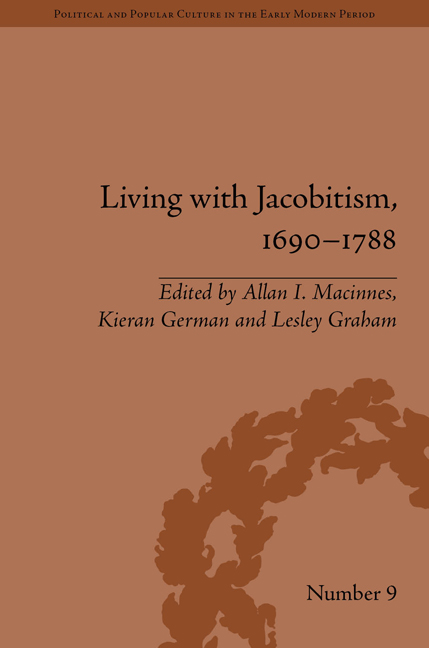Book contents
- Frontmatter
- CONTENTS
- List of Contributors
- List of Figures
- Abbreviations
- Preface: Breandán Ó Buachalla, A Tribute
- Introduction: Living with Jacobitism
- 1 The First Jacobite and the Scottish Parliament
- 2 The Scottish Jacobite Community at Saint-Germain after the Departure of the Stuart Court
- 3 Liturgy: The Sacramental Soul of Jacobitism
- 4 ‘Zealous in the Defence of the Protestant Religion and Liberty’: The Making of Whig Scotland, c. 1688–c. 1746
- 5 Jonathan Swift's Memoirs of a Jacobite
- 6 ‘Female Rebels’: The Female Figure in Anti-Jacobite Propaganda
- 7 Commerce and the Jacobite Court: Scottish Migrants in France,1688–1718
- 8 Ultramontane Ultras: The Intellectual Character of Irish Students at the University of Paris
- 9 To a Fair Meeting on the Green: The Order of Toboso and Jacobite Fraternalism, 1726–c. 1739
- 10 English and Scottish Jacobite Painters in Eighteenth-Century Rome
- 11 Polite War: Material Culture of the Jacobite Era, 1688–1760
- 12 Robert Adam: ‘My Mother's Dear British Boy’
- 13 From Jacobite to Jacobin: Robert Watson's Life in Opposition
- 14 Robert Louis Stevenson's ‘The Young Chevalier’: Unimagined Space
- Notes
- Index
Introduction: Living with Jacobitism
- Frontmatter
- CONTENTS
- List of Contributors
- List of Figures
- Abbreviations
- Preface: Breandán Ó Buachalla, A Tribute
- Introduction: Living with Jacobitism
- 1 The First Jacobite and the Scottish Parliament
- 2 The Scottish Jacobite Community at Saint-Germain after the Departure of the Stuart Court
- 3 Liturgy: The Sacramental Soul of Jacobitism
- 4 ‘Zealous in the Defence of the Protestant Religion and Liberty’: The Making of Whig Scotland, c. 1688–c. 1746
- 5 Jonathan Swift's Memoirs of a Jacobite
- 6 ‘Female Rebels’: The Female Figure in Anti-Jacobite Propaganda
- 7 Commerce and the Jacobite Court: Scottish Migrants in France,1688–1718
- 8 Ultramontane Ultras: The Intellectual Character of Irish Students at the University of Paris
- 9 To a Fair Meeting on the Green: The Order of Toboso and Jacobite Fraternalism, 1726–c. 1739
- 10 English and Scottish Jacobite Painters in Eighteenth-Century Rome
- 11 Polite War: Material Culture of the Jacobite Era, 1688–1760
- 12 Robert Adam: ‘My Mother's Dear British Boy’
- 13 From Jacobite to Jacobin: Robert Watson's Life in Opposition
- 14 Robert Louis Stevenson's ‘The Young Chevalier’: Unimagined Space
- Notes
- Index
Summary
In the summer of 1746, the Reverend Zachary MacAulay zealously assisted British forces searching on the island of Lewis for the fugitive Charles Edward Stuart, the Jacobite Prince decried by Whigs as the Young Pretender. Prince Charles escaped from Lewis unscathed, but Reverend MacAulay was forced off the island by parishioners disaffected by his Whig partisanship. A century later, his grandson Thomas Babington Macaulay brought cohesion, clarity and intellectual rigour to the Whig ideological perspective on the Revolution of 1689–91. The removal of James II and VII, the grandfather of Prince Charles, in favour of William of Orange, was resolutely presented as the triumph of Protestantism, property and progress. A historiographical tradition was thus firmly established that endured for most of the twentieth century. Jacobitism was treated dismissively. The principled commitment of the Jacobite supporters of the exiled house of Stuart was also belittled from an Anglocentric perspective. Irish and Scottish Jacobites died in considerable numbers during the Revolution deemed ‘Glorious’ by Whig historiography. Even though many more Scots and a few English died in the major rising of 1715–16 (hereafter the '15) and Scottish Highlanders in particular were brutalized in the aftermath of the last major rising in 1745–6 (hereafter the'45), the impact of Jacobitism was deemed peripheral to British state formation and global aspirations.
- Type
- Chapter
- Information
- Living with Jacobitism, 1690–1788The Three Kingdoms and Beyond, pp. 1 - 10Publisher: Pickering & ChattoFirst published in: 2014

